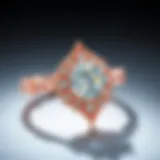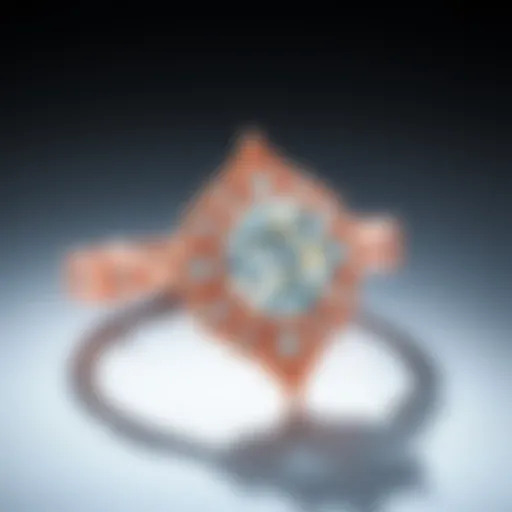Understanding the Diamond Cut Grading System
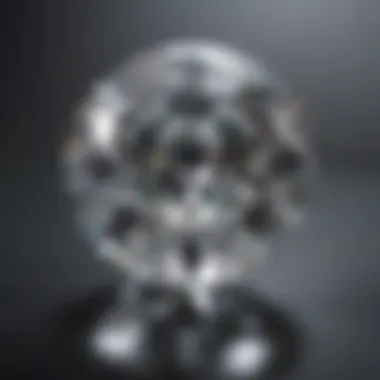

Intro
When it comes to diamonds, the cut is not just about shape; it's a fundamental component that affects how a diamond sparkles and shines. The term "cut" refers to several factors, including the stone's proportions, symmetry, and polish. The impact of these characteristics cannot be understated, as they play a crucial role in determining a diamond's overall beauty and value. Misunderstanding the intricacies of the cut grading system can leave even seasoned collectors in the dark, making it essential to shed light on this topic.
In a world flooded with diamonds of varying quality, knowing how to decipher the cut grading system is akin to having the map to hidden treasure. This article aims to pull back the curtain on the grading system and demystify what truly makes a diamond shine. We will examine the criteria involved in grading diamond cuts, their significance, and the relationship between cut quality and pricing.
Gemstone Overview
Description of the gemstone
Diamonds are much more than mere gemstones; they are nature’s masterpieces, forged under immense pressure over billions of years. These sparkling wonders come in various colors and can exhibit distinct characteristics based on their geological origins. While many envision diamonds as clear and colorless, they can actually be found in hues like blue, yellow, and even pink. Such diversity captures the hearts of gemstone enthusiasts—from folks seeking to adorn themselves to collectors looking to invest.
Physical properties
Diamonds stand out not only for their beauty but also for their remarkable physical properties:
- Hardness: Diamonds are the hardest natural material on Earth, rated 10 on the Mohs scale. This hardness makes them ideal for various applications, including cutting tools.
- Brilliance: The diamond's ability to reflect light is unprecedented. The cut and arrangement of the facets influence how well a diamond interacts with light, generating its enchanting sparkle.
- Clarity: This refers to the presence or absence of internal and external flaws, which can affect the stone's overall appearance. Clarity grading ranges from Flawless to Included.
- Color: While most observe diamonds as colorless, subtle shades can significantly influence their value. The absence of hue is prized, making these diamonds highly sought after.
Understanding these physical properties lays the groundwork for navigating the diamond cut grading system effectively.
"The cut is the soul of the diamond; without it, the brilliance is lost."
In the sections that follow, we will delve deeper into how these elements intertwine with the cut grading system, shedding light on what makes a diamond truly desirable.
Prelims to Diamond Cut Grading
When stepping into the dazzling world of diamonds, one soon realizes that not all glitter is gold—or, in this case, not all shine comes from the cut. The diamond cut grading system acts as a compass for both buyers and sellers, guiding them through the intricate landscape of valuation and beauty. This section delves into the essence of diamond cut grading, illuminating its importance in appraising these exquisite stones.
Understanding the Importance of Cut
The cut of a diamond serves as a linchpin in determining its overall allure. It has the potential to enhance—or detract from—the stone's brilliance and fire, the very qualities that leave onlookers mesmerized. Unlike the carat or clarity, which can be quantified more rigidly, the cut is nuanced and, to some extent, subjective. Factors like light performance, symmetry, and proportions come together to create a final product that can either dazzle the eye or appear lackluster.
In the realm of diamonds, having a solid grasp on cut grading can save a buyer from a costly oversight. A well-cut diamond can appear larger and more brilliant than a poorly cut stone of the same carat weight. In the long run, understanding cut grading empowers enthusiasts to make informed choices, ensuring that their investment is both aesthetically pleasing and valuable.
Historical Context of Diamond Cuts
The journey of diamond cutting has deep roots that can be traced back centuries. Initially, diamonds were worn in their natural, unpolished state, admired for their unique shapes and forms. But as the fascination with these gems grew, so too did the techniques employed to enhance their allure. Early methods leaned heavily on the brute force of simple polishing; however, it didn't take long for artisans to discover the magic of facets.
By the 15th century, the 'table cut' emerged in Europe, introducing the concept of flat surfaces to a diamond. This marked the beginning of a transformative era in diamond artistry. Fast forward to the 20th century and the advent of the modern round brilliant cut—an innovation that set the standard for cut quality.
Today, the diamond cutting industry continues to evolve, driven by technology and artistic flair. Historical perspectives provide a foundation for understanding today’s grading standards, showcasing how values and perceptions change over time in response to societal influences and tastes.
The diamond cut grading system is not just a technical tool; it is a reflection of our cultural evolution, a blend of art and science that continues to captivate people around the world.
The Anatomy of a Diamond Cut
Understanding the anatomy of a diamond cut is crucial for both enthusiasts and collectors. The physical aspects, such as facets and angles, influence not just the overall appearance of the diamond but also its perceived value. Each element plays a role in how light interacts with the gemstone, ultimately affecting its brilliance and fire. A diamond's cut is not merely about shape; it encompasses a broad range of considerations that dictate its visual appeal and market demand.
Key Components: Facets and Angles
Facets are the flat surfaces on the diamond that are meticulously shaped, while angles refer to the specific degrees at which these facets are positioned in relation to each other. A properly cut diamond should have numerous facets to create light reflections; this is what gives a diamond its sparkle. For example, a round brilliant cut typically has 58 facets. This specific cut is well-known for showcasing light dispersion, creating that iconic sparkling effect.
Furthermore, the angles of the facets significantly impact how light enters and exits the diamond. If angles are too steep or shallow, light may be lost instead of reflected back. This leads to the concept of the "light return," a critical aspect that determines a diamond's brilliance. Essentially, the goal is to find the perfect balance between facet arrangement and angle to maximize light performance.
- Good Facet Arrangement: Helps achieve maximum sparkle.
- Proper Angles: Prevents light from escaping, enhancing brightness.
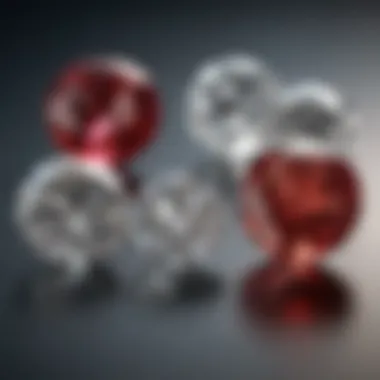

Every small detail counts, and even the slight misalignment of angles can lead to a noticeable difference in brilliance. Therefore, understanding this intricate interplay between facets and angles helps buyers appreciate the nuances of diamond quality.
Symmetry and Proportion in Cuts
Symmetry refers to the equality of the diamond's facets and their alignment relative to each other. A well-symmetrical diamond will have uniformly sized facets and is visually appealing. When looking at a diamond with high symmetry, it should appear harmonious to the eye; any lack of balance can disrupt the light performance and overall beauty. For instance, if one facet is slightly larger than its counterparts, it can draw the eye and may make the diamond appear less refined.
Proportion, on the other hand, pertains to the relationship between the various dimensions of the diamond, like its depth, table size, and overall shape. The proportions must complement each other to ensure optimum light return and aesthetic balance. If the table is too large compared to the depth, light may not bounce as effectively, diminishing brilliance.
- Symmetrical Cuts: Add to uniformity and harmony in appearance.
- Proportionate Settings: Enhance light performance and visual appeal.
To truly understand cut quality, one should consider both symmetry and proportion. A diamond may have superb facets but could still be visually bland if the symmetry is off. Achieving a perfect harmony in both aspects not only enhances the jewel's allure but also typically increases its value on the market.
"The beauty of a diamond lies in its cut, which allows it to capture the essence of light and transform it into breathtaking brilliance."
By comprehending these essential components of a diamond's anatomy, one can better appreciate the meticulous craft behind each gem. A quality diamond's cut is a blend of artistry and science, intended to showcase each unique stone in its best light.
The Grading Scale Explained
Understanding the grading scale is essential for anyone who wants to appreciate the art of diamond cutting. This scale serves as a comprehensive measure to assess how cuts influence a diamond's glimmer and desirability. It also works as a road map for buyers, guiding them through a maze of options and providing clarity on what constitutes a premium versus an average cut. The grading not only affects the perceived beauty of the stone but can also significantly impact its market value.
Overview of Cut Grades
When we talk about diamond cuts, we usually think of grades that range from poor to excellent. Each grade hinges on several criteria that delve deeper into the cut's complexity, offering insights into how well the diamond interacts with light and how its facets are engineered.
- Excellent: Represents the cream of the crop. It features the most precise angles and proportions, allowing light to reflect and refract in mesmerizing ways.
- Very Good: These are nearly indistinguishable from excellent cuts. They still hold their own in brilliance and fire, presenting a solid option for many buyers.
- Good: While not as stellar, good cuts still offer decent sparkle, and they can be more budget-friendly for those looking to balance quality with price.
- Fair: This neighborhood of cut begins to show noticeable performance issues. Light may escape instead of bouncing inside the diamond, which can lessen its overall visual appeal.
- Poor: A poor cut is one that fails to catch the eye. These stones often lack brilliance and can appear dull.
Each grade plays a pivotal role in setting the stage for buyers to evaluate their choices better. However, there is more to it; knowing where a diamond stands on the grading scale helps to manage expectations.
From Excellent to Poor: Criteria Breakdown
The path from excellent down to poor is paved with specific criteria, and understanding each aspect is key for any savvy buyer or gemstone enthusiast.
- Proportions: This aspect focuses on how the various parts of the stone relate to one another. An ideal proportion enhances the diamond's brilliance and sparkle. For example, a well-proportioned round diamond will generally feature a table percentage of around 53-58%.
- Symmetry: If a diamond is like a well-tuned orchestra, symmetry is its conductor. The facets should align symmetrically, as the slightest imbalance can taint its overall appearance. Graders look for harmonious shapes, especially in the pavilion and crown angles.
- Finish: This includes factors such as polish and clarity of the facets. A well-finished diamond reflects light uniformly, contributing to its brilliance. Conversely, a poorly finished diamond might exhibit a lackluster shine.
- Light Performance: A diamond’s ability to reflect and refract light is quintessential to its beauty. Excellent cuts optimize light dispersion, leading to that sparkling effect we admire, while poorer cuts simply don’t capitalize on this potential.
- Historical Context: A gem's cut is contextual—a reflection of the period when it was crafted. For instance, a vintage cut may offer aesthetic appeal despite a lower grading due to its historical significance.
In sum, knowing the breakdown of grades can transform the buying experience. The grading scale isn't just numbers; it's a language that communicates the artistry behind each stone. The depth of understanding gained here empowers buyers to make informed decisions, and this insight is invaluable when exploring the intricate world of diamonds.
Influence of Cut Quality on Diamond Value
The intricate art of diamond cutting is pivotal in determining not only the beauty of the gemstone but also its market value. When we talk about cut quality, we touch upon the very essence that allows a diamond to reflect light and showcase its sparkle. A well-crafted diamond is desirable, indeed, but understanding the nuances of cut quality can elevate one’s appreciation for these gems even further.
Diamonds are graded on multiple facets which stem from the cut itself: proportions, symmetry, and polish. Each of these elements plays a role in how light interacts with the stone. As a general rule, the more refined the cut, the greater the diamond's ability to dazzle, making it significantly more valuable than diamonds that are poorly cut. This reflects a deeper principle in the diamond industry—quality often trumps carat size when it comes to value.
Market Impact of Cut Quality
The marketplace is ever so sensitive to the subtleties of diamond cuts. If a diamond sparkles like the sun, buyers tend to magnify their interest, often throwin' caution to the wind regarding its carat weight. It’s essential to realize that a diamond’s cut can impact its selling price dramatically. A diamond that is graded as 'Excellent' can command prices significantly higher than one rated as 'Fair' or 'Poor', irrespective of size.
- Buyers Value Brilliance: A diamond's brilliance, which is the amount of light a diamond reflects, can make or break a sale. Buyers often gravitate toward stones that shine most brightly, leading to higher demand for finely cut diamonds.
- Comparison Shopping: With the advent of online marketplaces and platforms, buyers can easily compare diamonds side by side. This amplifies the value of cut quality as it becomes ever more visible against the competition.
- Resale Market: Well-cut diamonds often have a better resale value. This can be a significant consideration for buyers who view their purchases as long-term investments.
"A diamond's cut quality can truly turn a basic rock into a sparkling jewel that captivates all who see it."
Buyer Considerations When Evaluating Cut
For buyers, navigating the diamond world isn’t just about flashy appearances. It involves making informed choices based on cut quality. When evaluating a diamond, a potential owner should note two vital aspects:
- Understanding the Grading Scale: Familiarity with the grading criteria for diamond cuts, such as ideal proportions and the calculation of angles, allows buyers to differentiate between countless options on the market. Resources like the Gemological Institute of America (GIA) provide valuable insights here.
- Visual Inspection: Although reports and grades provide a solid baseline, nothing beats seeing a diamond in person. A diamond’s sparkle can be very subjective, so it’s beneficial to inspect it under different lighting—natural light, for instance, often reveals its true beauty.
Through thoughtful consideration of cut quality, a buyer can avoid pitfalls and steer away from diamonds that might appear appealing at first glance but ultimately lack the brilliance that brings value in both beauty and investment. An educated purchase not only ensures lasting satisfaction but also enhances one's knowledge and appreciation of these storied gems.
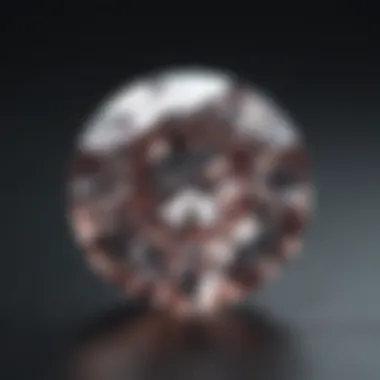

By paying close attention to these intricacies, buyers become informed members of the diamond community, capable of making decisions that align with their values and desires.
Industry Standards and Certification
The realm of diamonds is replete with nuances that can baffle even the most ardent enthusiasts. When it comes to cut grading, industry standards and certification act as pivotal guides. They offer an essential framework that enables buyers, sellers, and gem aficionados alike to make informed decisions. Without these standards, the diamond market could easily slip into chaos, leaving buyers at the mercy of subjective evaluations without a solid basis.
With the advent of rigorous grading practices, a common language emerged that cultivates trust within the industry. For anyone keen on investing in a diamond, being privy to the significance of these certifications is not merely ancillary; it's fundamental.
Role of Gemological Laboratories
Gemological laboratories serve as the arbiters of diamond assessment. These are specialized institutions staffed by experts who utilize advanced technology combined with years of experience to evaluate a diamond’s cut, clarity, color, and carat weight. Among the most esteemed labs are the Gemological Institute of America (GIA) and the American Gem Society (AGS). Each institution has its stringent criteria and methodologies, leading to varying grading outcomes, but all strive to maintain integrity and accuracy in their assessments.
Key roles played by these laboratories include:
- Objectivity: They provide an impartial analysis that eliminates biases.
- Expertise: Trained gemologists possess in-depth knowledge that most buyers lack, ensuring a thorough evaluation of each diamond.
- Technology Usage: They employ sophisticated tools like laser measuring devices and software designed for microscopic inspection, ensuring precision.
Furthermore, many buyers feel a sense of security receiving a certification accompanied by a report detailing the findings. Such documents don’t just bolster a diamond's resale value; they also instill confidence in the purchasing process.
Understanding Diamond Certification Reports
Certification reports are a diamond’s passport. These documents delineate a comprehensive overview of the diamond's characteristics—each one meticulously detailed to reflect its unique qualities. A typical report will encompass key areas such as cut quality, clarity grades, color ratings, and included features or inclusions.
A well-written diamond certification report generally includes:
- The 4Cs: The grade for cut, color, clarity, and carats—parameters that impact both the diamond's appearance and its market value.
- Diagram: Most reports come with diagrams illustrating the diamond’s inclusions, allowing potential buyers to scrutinize its internal structure visually.
- Laser Inscription: Certificates often indicate if the diamond is laser-inscribed with a unique identification number, linking it to its report—a form of authenticity verification that is increasingly coveted.
"A quality diamond report can make the difference between a wise investment and a financial misstep."
In summary, understanding the importance of industry standards and certification, along with the roles of gemological laboratories and the content of certification reports, can significantly influence your experience in the diamond market. Knowledge is power, and in the world of diamonds, it ensures that your passions align with informed decisions, ultimately leading to satisfaction in your purchases.
Evaluating Diamond Cuts: Expert Insight
When it comes to diamonds, the cut is often touted as the most critical factor affecting its beauty and brilliance. This section dives into the realm of expert evaluations, shedding light on how professionals assess diamond cuts. The importance of understanding this aspect lies in its implication for buyers seeking to make informed decisions, as well as for collectors who wish to deepen their knowledge of gemstones.
The evaluation of a diamond cut goes far beyond mere appearance. Experts look for the harmony of facets, angles, and proportions, all of which contribute to how light interacts with the stone. While anyone can admire a sparkling diamond, a professional's eye discerns subtle details that the average person might overlook. This expertise is central to understanding how much value a diamond holds in the marketplace.
Factors Considered by Professionals
Experts evaluate a diamond cut based on various criteria, each playing a unique role in defining the overall quality. The following are some key factors that jewelers and gemologists take into consideration:
- Proportion: The relationship between various dimensions is crucial. For instance, an ideal table percentage can enhance brilliance.
- Symmetry: A perfectly symmetrical cut ensures even light reflection which is pivotal for achieving that sought-after sparkle.
- Finish: This includes the polish and the quality of the facets, both of which significantly impact how light reflects off the diamond's surface.
- Light Performance: A diamond's ability to refract and dispense light correctly can make the difference between an average stone and an extraordinary one.
Each of these factors contributes to the overall desirability of the diamond. It’s intriguing to note how something as simple as a degree in angle can radically transform the visual and monetary value of a gem.
The Aesthetic Appeal of Diamond Cuts
Let’s face it, when you buy a diamond, it’s often the allure that hooks you. The way light dances in a diamond—creating a spectrum of colors and flashes—stems directly from how it has been cut. A well-crafted diamond can capture the eye, making it an important focus for anyone in the jewelry industry or a collector's circle.
Some might argue that beauty is subjective, but the aesthetics of a diamond cut can evoke universally recognized responses. A fine cut enhances not only the gem’s brilliance but also its fire—the colorful flashes of light—and scintillation—the sparkle brought on by the movement.
In evaluating diamond cuts, clarity of the facets and how they work in concert significantly marks a diamond's appeal. Well-executed cuts amplify light performance, leading to radiant, eye-catching gemstones. The true art of cutting is a delicate balance, and professionals often describe it as both science and art.
"A diamond’s beauty is not merely in its size, but in how perfectly it captures and reflects light."
Finale
Ultimately, gaining insight from experts on diamond cuts unveils the layered complexities behind this simple yet captivating stone. Understanding the evaluation process helps to appreciate the craftsmanship involved and enhances the overall experience of owning or purchasing a diamond. Engaging with professionals not only empowers buyers but also enriches their appreciation of the beauty found within these gemstones.
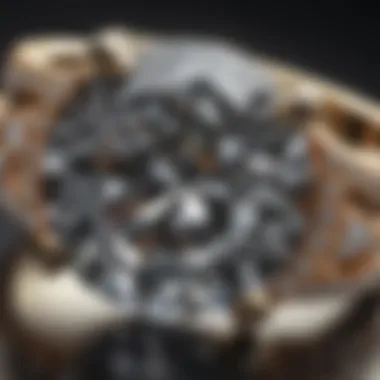

Common Misconceptions about Diamond Cuts
When it comes to diamonds, the charm and allure often lead to a tangled web of misunderstandings. Knowing the common misconceptions about diamond cuts is vital for anyone wanting to navigate the glittering world of gemstones. Understanding these myths not only fosters informed decisions but also enhances appreciation for the artistry behind diamond cutting. Misconceptions can affect purchasing behavior, lay perceptions on value, and ultimately shape the market. A well-equipped buyer stands to benefit greatly from shattering these myths.
Debunking Myths in Cut Grading
One prevailing myth is that just any cut can achieve brilliance. Cut grading is meticulously assessed across various criteria, including proportions, symmetry, and polish, which all work together to create that enchanting sparkle. A diamond that is simply labeled as "brilliant" does not necessarily mean it shines the brightest. Instead, a "poorly cut" diamond might not reflect light properly, resulting in a lackluster appearance. It's wise to remember: "All that glitters is not gold," and in the diamond cutting realm, not all cuts shine equally.
Another common misconception revolves around the belief that the diamond's carat weight is the only thing that matters. While carat weight certainly plays a role in determining value, it's merely a part of the puzzle. A smaller diamond with an exceptional cut can be more valuable than a larger diamond with inferior cutting. This leads to a critical piece of advice: assess cut quality closely, because in the end, a well-cut diamond can outshine its heftier counterparts.
"Cut is the one attribute that can make even a mediocre diamond look splendid."
Additionally, there’s a notion that all diamonds are graded equally regardless of their certification authority. This is simply untrue. Different gemological laboratories may have varied grading scales and criteria. Some institutions like the Gemological Institute of America (GIA) and the American Gem Society (AGS) have established reputations for precise grading systems, while others may not hold these high standards. Thus, buyers must inquire about the grading report for any diamond they consider purchasing.
Understanding the True Value of a Well-Cut Diamond
Well-cut diamonds truly hold intrinsic value, not just visually but also in terms of market worth. The precise angles, the quality of craftsmanship, and the overall symmetry all contribute to a diamond’s ability to reflect and refract light beautifully. Individual facets should interplay in harmony, seizing the onlookers' gaze and leaving a lasting impression.
Moreover, the market tends to favor well-cut diamonds. As trends evolve, buyers are increasingly drawn to the visual characteristics that well-cut diamonds offer. A beautiful sparkle can influence emotions and decisions, often translating into higher prices during resale. It’s crucial for potential buyers to recognize that investing in a well-cut diamond equates to investing in beauty and desirability, which often leads to better resale value in the long run.
Ultimately, the journey of discovering the true worth of a diamond goes beyond mere aesthetics. It encapsulates the story behind its creation, the science of its grading, and the emotional resonance it evokes. By understanding the myths surrounding cut grading and emphasizing the value of a well-cut diamond, buyers can engage in the diamond market with informed confidence.
Future Trends in Diamond Cutting and Grading
As the diamond industry continuously evolves, it's crucial to stay attuned to the future trends in diamond cutting and grading. The interplay of technological advancements and shifting consumer preferences not only influences the quality of diamonds but also their market dynamics. This section delves into several key trends poised to reshape how diamonds are cut and graded, providing insights that are valuable for both buyers and sellers.
Technological Advances Affecting Cut Quality
Over recent years, technology has made significant inroads into the world of diamond cutting. Innovations such as computer-aided design (CAD) and laser cutting have transformed the traditional methods once adopted by jewelers. These tools allow for precise cuts that enhance brilliance and maximize a diamond's inherent quality.
- Enhanced Precision: With laser technology, cutters can achieve exact angles and measurements, which contribute directly to the diamond's overall sparkle. This level of precision was unattainable with older tools.
- Computer Simulations: Using advanced software, gemologists can simulate how different angles and facets will affect light performance. This means cutters can predict how changes will enhance or diminish beauty before making a cut.
- 3D Printing: The use of 3D technology in creating prototypes for diamond settings allows jewelers to visualize and refine designs before the actual metalwork begins, ensuring a perfect fit.
A newer approach involves artificial intelligence (AI) systems which can assist in grading diamonds by evaluating light performance and cut quality with remarkable accuracy. Such technology can sift through more diamonds in less time, allowing professionals to focus their expertise where it matters most.
Emerging Standards in the Industry
As technological capabilities expand, the diamond grading industry is also witnessing the rise of new standards aimed at enhancing transparency and trust. Understanding these standards is essential for consumers who want to make informed purchasing decisions.
- Sustainability Measures: With rising awareness of ethical sourcing, buyers are leaning towards diamonds that are cut and graded under eco-friendly practices. Certifications such as the Kimberley Process have set a benchmark for conflict-free diamonds, pushing more jewelers to adopt sustainable practices.
- Blockchain Technology: There's a buzz about utilizing blockchain for tracking the journey of a diamond from mine to market. This not only ensures authenticity but also helps in verifying claims of ethical sourcing.
- Enhanced Grading Systems: New grading methodologies incorporate not just the traditional metrics but also emotional and aesthetic factors. This holistic approach aligns better with consumer desires and helps buyers appreciate the artistry behind the cut.
"The diamond industry adapts constantly, and these changes pave the way for a brighter, more ethical future," says an industry expert.
Epilogue: The Lasting Legacy of the Diamond Cut System
The diamond cut grading system stands as a crucial pillar in the realm of gemstones, deeply entwined with the diamond's allure and overall value. This article has navigated through various aspects of this complex grading system, leading to an understanding that goes beyond mere numerics or letters associated with cut quality. Such clarity can foster not only appreciation but also informed decisions when purchasing these luxurious stones.
In summary, the legacy of the diamond cut system is much more than a relic from the past; it is a living framework that continues to evolve alongside technological advancements and shifting buyer preferences. The knowledge encapsulated here provides a robust foundation. Understanding how cut characteristics contribute to a diamond’s brilliance, fire, and scintillation is essential for anyone involved in the jewelry trade, whether they’re sellers, designers, or collectors. A better grasp will enhance one’s ability to assess the true value of a stone, allowing buyers to invest wisely.
Summarizing Key Takeaways
- The diamond cut grading system is at the heart of assessing a diamond's value and beauty.
- Each diamond's cut can range from Excellent to Poor, with distinct criteria used to determine where it falls on this scale.
- Understanding facets, angles, and proportions significantly impacts the stone's aesthetic appeal and light performance.
- Misconceptions around diamond cuts are common, but clarity in this area elevates the purchasing experience.
- The ongoing developments in cutting techniques and grading standards illustrate the industry's commitment to quality and transparency.
"A diamond is more than just a piece of jewelry—it's a measure of personal value, defined by the aspects that make it unique."
Encouraging Informed Purchases
When it comes to buying diamonds, knowledge is the real power play. Informed purchases stem from understanding the grading system and recognizing that cut quality vastly influences both appearance and price. Potential buyers should arm themselves with insights from expert evaluations and certification reports from respected gemological laboratories.
Consider these key points:
- Look for certifications that provide detailed assessments, such as those from the Gemological Institute of America or the American Gem Society.
- Don't be swayed solely by prices or marketing gimmicks. Instead, understand what you are buying— the cut is often where significant value lies.
- Seek professional advice when needed, especially when aiming for a particular aesthetic that aligns with personal taste.
Investing in a well-cut diamond is not just about acquiring a beautiful item; it represents an informed decision that adds value to one’s collection or gift—standing the test of time both in quality and sentiment.
